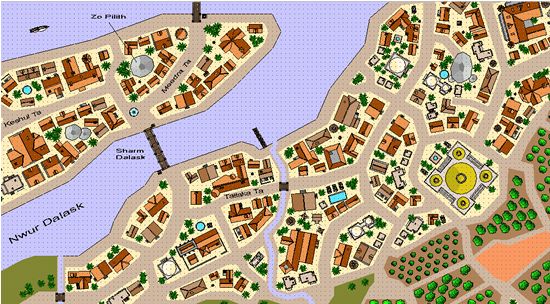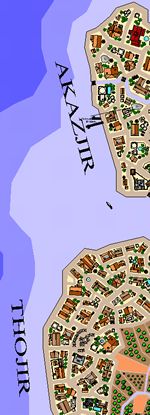The Dreaming City
- Ruler(s) – Lady Elzàjre Aljeðaar
- Population – Jædðyr 78,630 (650 DR)
- Elevation – 20 feet
The City of Jædð is built upon the delta of the ponderous Run Sùlūð. The area around the City of Jædð is surrounded by a thick veil known as the Dreaming Ring.
“The first time I came to Jædð I smelled the City before it came into view through the evening haze. The sun was setting behind us as the galley-men rowed us into port, the sound of the oars soon fading into the sounds of the bustling docks. Ships with sails of all colors were moored there. Endless chains of men and beasts unloaded exotic wares from the ships and loaded cloth, casks, and crates back on board. As we drew closer the crew grew more nervous. This was the first truth that I learned of the City; visitors cannot wait to leave but natives remain relaxed and calm. A lethargy hangs over the City that crouches on the edge of the Dreamlands. Though the Temple of Sūdul stands abandoned in the Old Quarter her heavy presence is breathed with every step. The second thing I noticed about the City were the high vine shrouded stones. The Jædðàri call them pilith, and they tower above all the buildings and wooden walkways like sentinels of Wōd. Many support spiraling walkways and over-reaching platform houses; most near the Sha’al neighborhoods others are left in their natural state. The Sha’al do however cover their bases with intricate reliefs, some of which are worn beyond recognition and older than the surrounding City. As our ship moved into the City through the Run Sùlūð delta I was struck by the variety of the people that mill through the streets, and the intermingled architectures borrowed from homelands far more distant than I’ve traveled. The piers were filled with the expressionless dull-violet Nūð, a slave-race found deep within the Dreamland jungles. All stopped for a moment to watch our ship pass, but were whipped back to duty. There was no outwardly obvious pain or recoiling from the whips, but they continued working just the same.” – A Visitor Arrives in Jædð
There are many different styles of buildings within the City. Most structures are not dissimilar from the Ēōyn-influenced Dekàli architecture found in southern Ildûn. The Ēun style is recognizable by its half-timber frame construction with the addition of heavy and sometimes quite elaborate, eaves. Within Jædð, the houses are mortared with a tabby cement made from crushed river shells. Most large houses incorporate Sha’ali adaptations like upper-story breeze-throughs. The roofs of Ēun houses are not thatched like their northern ancestors, but lined with pressed-leaf shingles, a technique learned from the Sha’al (though not used on their buildings).
The Sha’ali building style has not changed in a thousand years. Ancient Sha’al dwellings found buried throughout the southern Dreamlands look much the same as Sha’al residences today. Sha’ali buildings are built with fired clay bricks and finished with plaster. Domes are common. The interiors are elaborately painted with religious iconography. The Sha’al value cleanliness and can regularly be found scrubbing their homes to keep the encroaching plants and molds from their pristine walls, or the horç nuts from piling on their roofs.
Ōdhórō building is more primitive than either Dekàli or Sha’ali styles. Ōdhórō structures are mostly round huts built using upright trees, ribbed with wooden hoops, and bound together at a peak. The houses are covered with woven reed sheets which are then plastered with mud and clay. The huts are typically one-room buildings with a fire-pit in the center. The finished buildings are painted white and covered with colorful illustrations and family designs. Wealthier Ōdho chain many of the round houses together to achieve a multi-roomed structures. Most Ōdho houses are built in family groups. Larger families consist of many concentric circles of houses. There are few Ōdho circle-settlements within the City of Jædð.
Wards
Built on marshy delta banks, the City of Jædð has six main divisions:Landmarks
- Dalūj Malar (i.e., Inn of the Terrible Flood)

